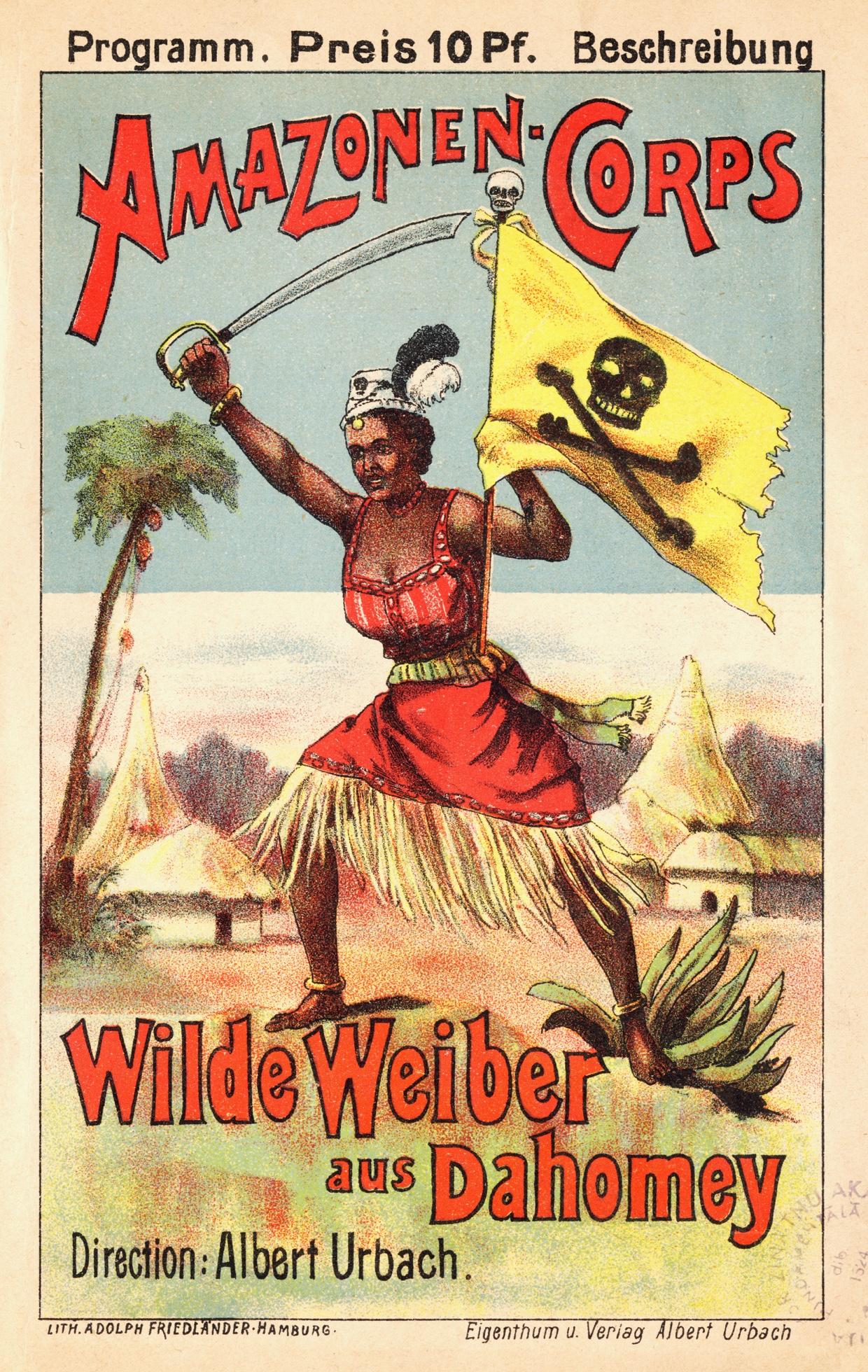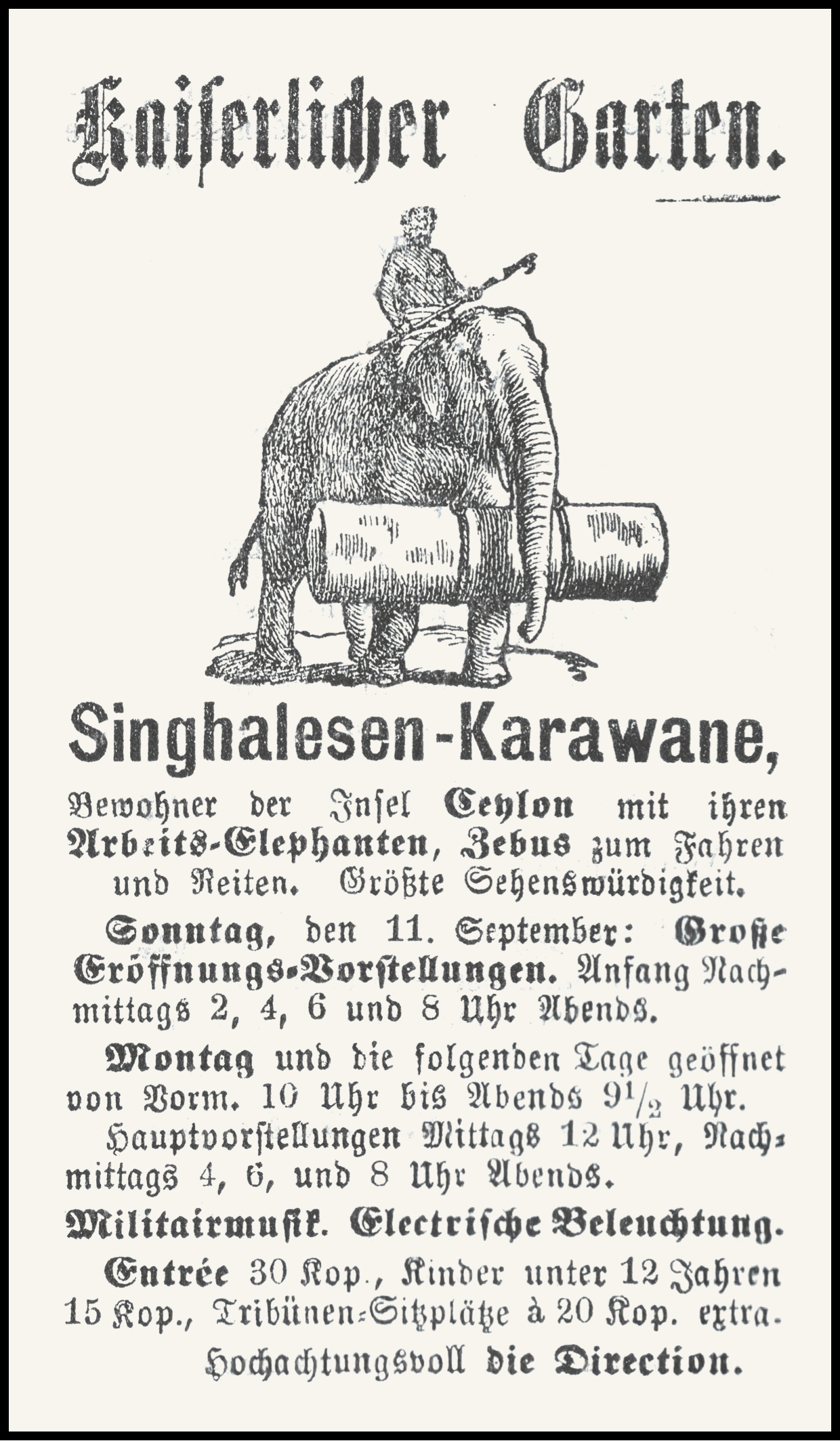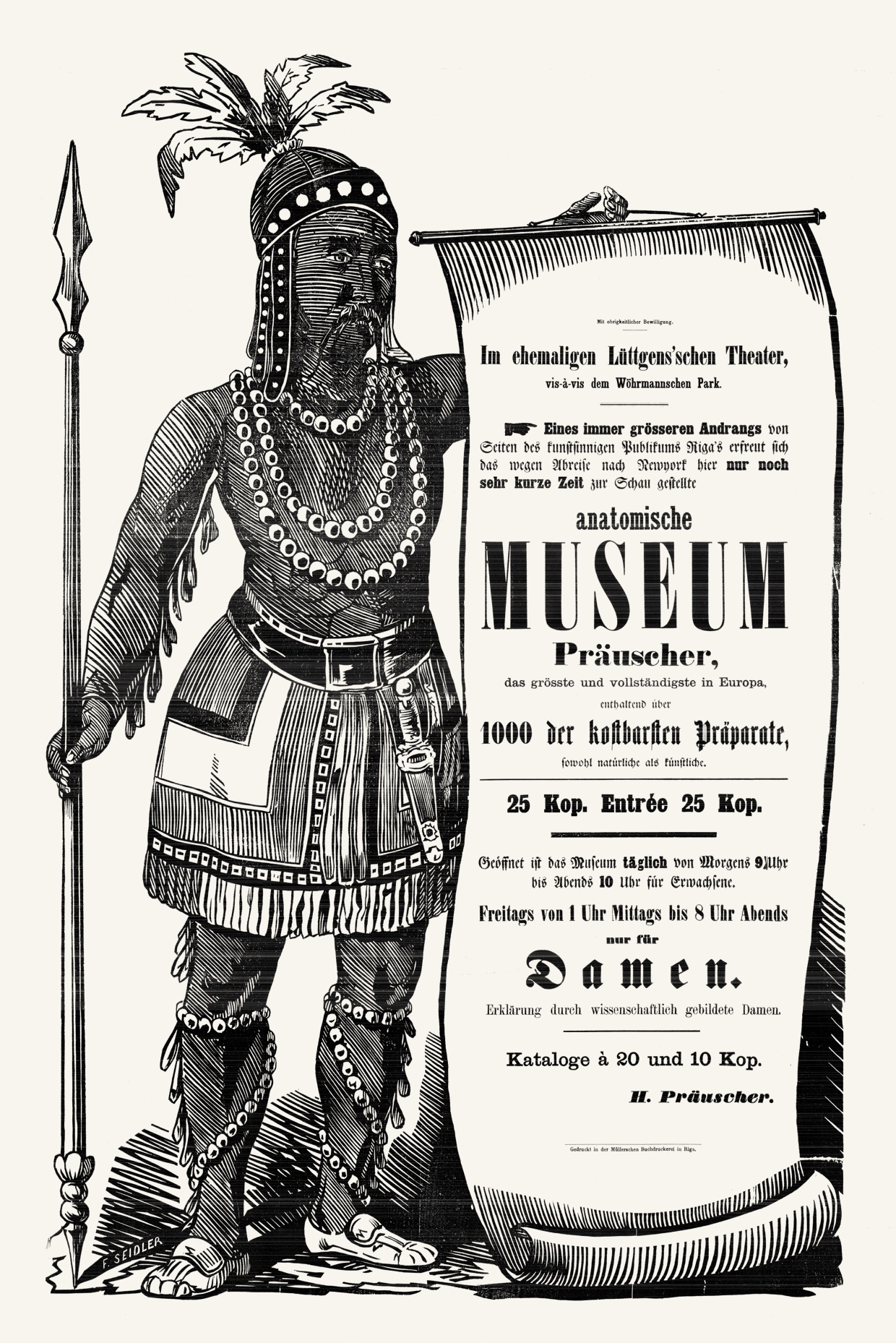THE TRILINGUALISM OF THE PRESS: DIFFERENT ATTITUDES TOWARDS ETHNOGRAPHIC SHOWS
Riga, located on the way to St. Petersburg, was a favourite centre for ethnographic shows in Eastern Europe. Being under the Russian Empire the city was inhabited by many ethnic groups, with a powerful and wealthy layer of society—Russians and Baltic Germans—as well as Latvians, Jews, Poles. Thus, in Riga, information regarding performances by non-European people appeared in Russian-, German-, and Latvian-language periodicals. Most of ethnographic shows within contemporary Latvia were organised in Riga. There are also some examples from Jurmala and Liepāja. In Latvia, which was then a part of the Russian Empire, shows featuring non-European Others were involved in the development of Latvian national consciousness. Aware of the dominant position of Baltic Germans and Russians, Latvians as a nondominant nation expressed compassion toward non-European peoples, as they partially identified with their situation. Although Latvians were convinced of their own civilisational superiority over non-European peoples, because of the internal threats the Latvian-speaking population was facing and the fact that it harboured no colonial ambitions, the role ethnographic shows played was associated with national identity formation.
Amazons of Dahomey shows at the Riga jubilee
Vogelwiese—Putnu pļava—Ptichiy lug, Riga, June 1901

Advertisements for the Dahomey Amazon Corps show in the context of Riga’s 700th anniversary, Putnu pļava (Vogelwiese), Riga, June 5–9, 1901. Source: Collection of materials from Riga’s 700th anniversary. Department of Manuscripts and Rare Books, University of Latvia Academic Library.
![]()
Dahomey Amazon shows in the Russian-language press
The 700th anniversary of Riga turned out to be very pompous. … The festive noise was made up of very diverse sounds. The music of trumpets from the tower of St. Peter’s Church, the sirens of ships and the voices of the Midsummer Night celebrants merged here. As well as the harmony expressed by the Finnish orchestra, the terrible roar of the Dahomey, the brave melodies of improvised Venice, and other noise that came from the Ptichiy lug (Vogelwiese Putnu pļava).
Source: Rizhskii Vestnik, September 1, 1901.
There is no doubt that in such form as the current exhibition is arranged, with a predominance of a decorative amusement, it very weakly meets its main goal. Old Riga and the Ptichiy lug, as well as concerts at the exhibition’s halls and in the Stelkovii Sad (Strēlnieku dārzs), have nothing in common with the exhibition, although they are the main interest of the public, and the exhibition itself is like an appendage to them.
Source: Rizhskii Vestnik, July 2, 1901.
![]()
Dahomey Amazon shows in the Latvian-language press
Across the street (in Vogelwiese—Putnu pļava—Ptichiy lug) is a Dahomey village, behind a wall or, better to say, a fence, ‘pagans’ beat their drums and sing their monotonous songs. The audience visits them quite a lot, but the guests could be even more if the village had a signboard in Latvian. It is incomprehensible that the pagans have not found ‘their moral duty’ to hang out a signboard in Latvian as well, because in Riga only Latvians are able to visit the village in large numbers. There is a signboard saying “Dahomen–Pagast” in the village, but Latvians think that it is in Estonian and the inscription in their language is still missing. However, if the mentioned text has not been written in Estonian, then only God might know in what language it is—probably in the pagan language itself. If so, then it would not be difficult for us to talk with such pagans.
Source: Dienas Lapa, June 8, 1901.
Better that we not say anything about the third part of the exhibition, the so-called “Putnu pļavu” (Vogelwiese, Ptichiy lug). In our eyes, it is an unworthy and small, and even worthless, addition to the anniversary of Riga.
Source: Baltijas Vēstnesis, June 8, 1901.
![]()
Dahomey Amazon shows in the German-language press
A real battle develops against the poignant picture, because with deafening weapons and terrible roars, the wild women of Dahomey, the African Amazons, united with their men, rush over one another and fight real battles, in which one can become fearful and anxious. Wild dances with terrible music are also performed, the black eyes shine like burning candles and the bared white teeth stand out dazzlingly against the black features. But there are also beauties among these women who, when they smile, want to say to Karmen: “Be careful!” In this area, the (Vogelwiese—Putnu pļava—Ptichiy lug) is the most interesting field for the observer, who is involuntarily drawn into the stream of zest for life, because on him it sounds in all dialects.
Source: Duna Zeitung, June 6, 1901.
Trilingualism: Advertisements for a Samoyed performance, Ķeizardārzs, Riga, February 5–26, 1889. Source: Rīgas Pilsētas Policijas Avīze = Vedomosti Rizhskoi Gorodskoi Policii = Zeitung den Rigaschen Stadtpolizei, February 7, 1889.
Advertisement for Sinhalese show in Ķeizardārzs, Riga, September 11–28, 1888. Source: Zeitung für Stadt und Land, September 11, 1888.
The Sinhalese were described as residents of a British colony. The description included reports on their physical (shorter than Europeans, but with wider chests and more muscled, thin waist, small hands and legs, brown skin, men wear black moustaches, hair woven in a braid, brown kind eyes) and social (they wear a turban like the Turks, women put combs in their hair, they do not wear footwear, decorate themselves with strings, coloured beads and ribbons) appearance, as well as their behaviour (eat modestly, do not consume alcohol, communicate with viewers in English and German, are polite). A significant note, important to Latvians, has been stressed in the article—“while farmers in the northern lands had to work hard on their piece of land for it to bear the needed fruit, the Sinhalese people did not have to sweat, as everything grew there in great plenty by itself” (Mājas Viesis, September 3, 1888). The Sinhalese people were being shown as kind people, in no way importunate. They were also proud humans, as they did not say that they were not feeling well in our climate because they were very cold (Mājas Viesis, September 24, 1888). Interestingly descriptions of Sinhalese habits included comparisons with ancient Latvians (Latviešu Avīzes, August 13, 1886), who also exhibited ‘wild’ habits before accepting Christianity. And the people involved in the ethnographic shows, too, especially the Sinhalese people, are similar in their feelings to Latvians in that they long for their homeland and family, as no matter whether a man of nature or culture, he has love in his heart (Mājas Viesis, September 24, 1888).
In addition to live shows of non-European peoples, exhibitions were organised in museums. They were visited by viewers and provided knowledge about the contemporary world. An example of this was the exhibition of representatives of various races.
Five people of different races, a Hindu from Madras, a North American from Red Island, a South American from Antigua, an African from Iefolt (?), an Australian from Papua New Guinea, at the former Delsner house opposite the Commercbank, Audēju Street, Riga, November 23—30 (?), 1835. Source: Department of Manuscripts and Rare Books, University of Latvia Academic Library.
Exhibition of mannequins (?) presented by the Präuscher Anatomische Museum, Lüttgens’schen Theatre, near to Vērmaņdārzs, Riga, June 4–July 7 (?), 1867. Source: Department of Manuscripts and Rare Books, University of Latvia Academic Library.
Poster of Aztecs from Mexico staged on Audēju Street 12, Riga, December 18, 1897–January 4, 1898. Source: Rīgas Pilsētas Policijas Avīze—Vedomosti Rizhskoi Gorodskoi Policii—Zeitung den Rigaschen Stadtpolizei, December 25, 1897.
At the end of 1897, a newspaper published in the territory of modern Latvia invited its readers to go to the centre of Old Riga, where Maximo and Bartelo—the last real Aztecs on earth—could be seen. The event was promoted as a great opportunity to see with their own eyes the last representatives of the lost civilisation. At the beginning of July of the following year, together with India’s jugglers and snake throwers (Truppe Indischer Gaukler und Schlangenbeschworer), the Aztecs were also on display in Liepāja market (Libausche Zeitung, July 11, 1898).
Poster of the “Man from Fire Island”, Kaļķu Street 15, Riga, 1866. Source: Department of Manuscripts and Rare Books, University of Latvia Academic Library
The Department of Manuscripts and Rare Books at the University of Latvia Academic Library has in store several posters that included messages still waiting to be deciphered. They contain information about the date and place of the event, but not about the year. Many such posters can be attributed to the freak shows that took place in the territory of Latvia, but there are also those that tell about the exhibition of non-European otherness. One example is the visit of an Aboriginal man from the Feuer Insel. He had been staged in Kaļķu street 15, Riga from July 20 – August 26? and later – in hut Nr.5 nearby Vērmaņdārzs park for a week, started with August 30. He was in Jelgava (Mitau) for two (?) days, the advertisement was published at August 28 with added remark that the venue will be announced by posters.
![]()
Credits:
Ilze Boldāne-Zeļenkova, Latvian University in Riga; Dagnosław Demski, Institute of Archaeology and Ethnology, Polish Academy of Sciences






